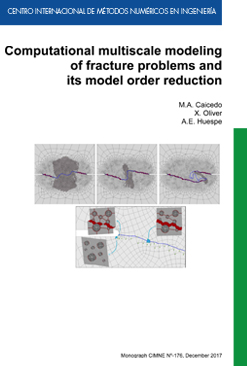Computational multiscale modeling of fracture problems and its model order reduction
FREE!
Editorial: CIMNE
Year of publication: 2017
Pages: 281
Editorial: CIMNE
Year of publication: 2017
Pages: 281
Description
This work focuses on the numerical modeling of fracture and its propagation
in heterogeneous materials by means of hierarchical multiscale models based
on the FE2 method, addressing at the same time, the problem of the excessive
computational cost through the development, implementation and validation of
a set of computational tools based on reduced order modeling techniques.
For fracture problems, a novel multiscale model for propagating fracture has been
developed, implemented and validated. This multiscale model is characterized by
the following features:
• At the macroscale level, were adapted the last advances of the Continuum
Strong Discontinuity Approach (CSDA), developed for monoscale models,
devising a new finite element exhibiting good ability to capture and model
strain localization in bands which can be intersect the finite element in
random directions; for failure propagation purposes, the adapted Crack-path
field technique (Oliver et al., 2014), was used.
• At the microscale level, for the sake of simplicity, and thinking on the development
of the reduced order model, the use of cohesive-band elements,
endowed with a regularized isotropic continuum damage model aiming
at representing the material decohesion, is proposed. These cohesive-band
elements are distributed within the microscale components, and their
boundaries.
The objectivity of the solution with respect to the failure cell size at the microscale,
and the finite element size at the macroscale, was checked. In the same way, its
consistency with respect to Direct Numerical Simulations (DNS), was also tested
and verified.
For model order reduction purposes, the microscale Boundary Value Problem
(VBP), is rephrased using Model Order Reduction techniques. The use of two
subsequent reduction techniques, known as: Reduced Order Model (ROM) and
HyPer Reduced Order Model (HPROM or HROM), respectively, is proposed.
First, the standard microscale finite element model High Fidelity (HF), is projected
and solved in a low-dimensional space via Proper Orthogonal Decomposition (POD).
Second, two techniques have been developed and studied for multiscale models,
namely: a) interpolation methods, and b) Reduced Order Cubature (ROQ) methods
(An et al., 2009). The reduced bases for the projection of the primal variables,
are computed by means of a judiciously training, defining a set of pre-defined training trajectories.
For modeling materials exhibiting hardening behavior, the microscale displacement
fluctuations and stresses have been taken as primal variables for the first and
second reductions, respectively. In this case, the second reduction was carried out
by means of the stress field interpolation. However, it can be shown that the stress
projection operator, being computed with numerically converged snapshots,
leads to an ill-possed microscale reduced order model. This ill-poseddness is
deeply studied and corrected, yielding a robust and consistent solution.
For the model order reduction in fracture problems, the developed multiscale
formulation in this work was proposed as point of departure. As in hardening
problems, the use of two successive reduced order techniques was preserved.
Taking into account the discontinuous pattern of the strain field in problems
exhibiting softening behavior. A domain separation strategy, is proposed. A
cohesive domain, which contains the cohesive elements, and the regular domain,
composed by the remaining set of finite elements. Each domain has an individual
treatment. The microscale Boundary Value Problem (BVP) is rephrased as a
saddle-point problem which minimizes the potential of free-energy, subjected to
constraints fulfilling the basic hypotheses of multiscale models.
The strain flucuations are proposed as the primal variable for the first reduction,
where the high fidelity model is projected and solved into a low-dimensional
space via POD. The second reduction is based on integrating the equilibrium
equations by means of a Reduced Order Quadrature (ROQ), conformed by a set of
integration points considerably smaller than the classical Gauss quadrature used
in the high fidelity model.
This methodology had been proven to be more robust and efficient than the
interpolation methods, being applicable not only for softening problems, but also
for hardening problems.
For the validation of the reduced order models, multiple test have been
performed, changing the size of the set of reduced basis functions for both
reductions, showing that convergence to the high fidelity model is achieved
when the size of reduced basis functions and the set of integration points, are
increased. In the same way, it can be concluded that, for admissible errors (lower
than 5%), the reduced order model is 110 times faster than the high fidelity
model, considerably higher than the speedups reported by the literature.
Additional information
| Year of Publication | 2017 |
|---|---|
| format | Monograph |

